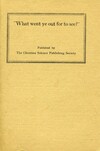

Are you sure?
This bookmark will be removed from all folders and any saved notes will be permanently removed.
Jesus of Nazareth
Originally published in the 1915 pamphlet titled “‘What went ye out for to see?’”
The words of Isaiah the prophet spoken to Ahaz the king, "at the end of the conduit of the upper pool in the highway of the fuller's field," had sunk deeply into the consciousness of the people. Told to demand a sign of divine protection, Ahaz had hesitated. It was not that he doubted the power of the prophet, but that he feared his requirements. A change of policy was one thing, but that he knew would not prove radical enough. What was called for was a change of life, and so Ahaz faltered. His silence was filled by Isaiah with astonishing completeness: "Hear ye now, O house of David; Is it a small thing for you to weary men, but will ye weary my God also? Therefore the Lord himself shall give you a sign; Behold, a virgin shall conceive, and bear a son, and shall call his name Immanuel." The saying of the prophet must have been treasured by every Hebrew maiden. To become the mother of the Messiah must necessarily have been the secret hope of all. It was only a question of time when a woman would arise pure enough to realize the full significance of the promise. At last in the caravansary at Bethlehem that promise was fulfilled. In the words of Mrs. Eddy on page 29 of Science and Health, "The illumination of Mary's spiritual sense put to silence material law and its order of generation, and brought forth her child by the revelation of Truth, demonstrating God as the Father of men."
It was this miracle of the virgin-birth—for a miracle is only some spiritual manifestation which seems wonderful, even incredible, to the human senses—that constituted the difference between Jesus of Nazareth and the other children who played round the carpenter's shop in the little hillside town of Nazareth. The writers of numerous uncanonical gospels have expended all their ingenuity in drawing a picture of the Messiah in these days. There were no Dantes among them. They drew clumsily, with a material brush, on the vellum of their own superstition; and they depicted, not the Jesus of the evangelists, but a Jesus born of a human sense of supernatural wonder-working. The genuineness of the gospel records shows itself in nothing so completely as in their quiet reticence. Directly or indirectly the writers knew Jesus as he had walked and taught during his ministry. They were far too clear, too scientific, to dwell on that which was hidden from them in a glass all too darkly. The manuscript makers of later days, foundering in their own ignorance, went out to paint the Christ, and succeeded only in preserving the likeness of a magician.
Enjoy 1 free Sentinel article or audio program each month, including content from 1898 to today.
JSH Collections
This article is included in:
1915 - PAMPHLET
"What went ye out for to see?"
JSH-Online has hundreds of pamphlets, anthologies, and special editions for you to discover.


